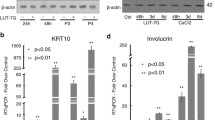Summary
The effects of dithranol and its therapeutically inactive oxidation product, danthrone, on 12(S)-HETE binding to the human epidermal cell line SCL-II were studied. Dithranol (0.25–1 Μg/ml), in contrast to danthrone, induced a substantial decrease in 12(S)-HETE binding in a dose-dependent manner. The inhibition occurred after a latency period of 6 h, reached its maximum at 18–24 h and slowly declined thereafter. At a concentration of 1 Μg/ ml, the drug led to an approximately 50% decrease in the number of specific high-affinity 12(S)-HEFE receptors (Bmax), whereas receptor affinity (Kd) showed no change. The down-regulation of 12(S)-HETE receptors on epidermal cells by dithranol may contribute to its antipsoriatic action.
Similar content being viewed by others
References
Anderson R, Lukey P, Dippenaar U, Eftychis HA, Findlay GH, Wooten MW, Nel AE (1987) Dithranol mediates pro-oxidative inhibition of polymorphonuclear leukocyte migration and lymphocyte proliferation. Br J Dermatol 117:405–418
Bedord CJ, Young JM, Wagner BM (1983) Anthralin inhibition of mouse epidermal arachidonic acid lipoxygenase in vitro. J Invest Dermatol 81:566–571
Bjerke JR, Livden JK, Degre M, Matre R (1983) Interferon in suction blister fluid from psoriatic lesions. Br J Dermatol 108:295–298
Boukamp P, Rupniak TR, Fusenig NE (1985) Environmental modulation of the expression of differentiation and malignancy in six human squamous cell carcinoma cell lines. Cancer Res 45:5582–5592
Bürgisser EJ (1988) MxN-FIT. An IBM-PC program for the analysis of complex binding data according to the law of mass action. Bureco AG, Rheinfelden
Carr C, Higgs GA, Salmon JA, Spayne JA (1981) The effects of arachidonate lipoxygenase products on leukocyte migration in rabbit skin. Br J Pharmacol 73:253P-254P
Chan C-C, Duhamel L, Ford-Hutchinson A (1985) Leukotriene B4 and 12-hydroxyeicosatetraenoic acid stimulate epidermal proliferation in vivo in the guinea pig. J Invest Dermatol 85:333–335
Dowd PM, Black AK, Woollard PM, Camp RDR, Greaves MW (1985) Cutaneous responses to 12-hydroxy-5,8,10,14-eicosatetraenoic acid (12-HETE). J Invest Dermatol 84:537–541
Fuchs J, Nitschmann WH, Packer L (1990) The antipsoriatic compound anthralin influences bioenergetic parameters and redox properties of energy transducing membranes. J Invest Dermatol 94:71–76
Greaves MW, Camp RDR (1988) Prostaglandins, leukotrienes, phospholipases, platelet activating factor, and cytokines: an integrated approach in inflammatory of human skin. Arch Dermatol Res 280 [Suppl]:33–41
Gross E, Ruzicka T, Restorff B, Stolz W, Klotz K-N (1990) High-affinity binding and lack of growth-promoting activity of 12(S)-hydroxyeicosatetraenoic acid [12(S)-HETE] in a human epidermal cell line. J Invest Dermatol 94:446–451
Hammarström S, Hamberg M, Samuelsson B, Duell EA, Stawiski M, Voorhees JJ (1975) Increased concentrations of nonesterified arachidonic acid, 12L-hydroxy-5,8,10,14-eicosatetraenoic acid, prostaglandin E2 and prostaglandin F2 in epidermis of psoriasis. Proc Natl Acad Sci USA 72:5130–5134
Hammarström S, Lindgren JA, Marcelo C, Duell EA, Anderson TF, Voorhees JJ (1979) Arachidonic acid transformation in normal and psoriatic skin. J Invest Dermatol 73:180–183
Kammerau B, Zesch A, Schaefer H (1975) Absolute concentrations of dithranol and triacetyl-dithranol in the skin layers after local treatment: in vivo investigations with four different types of pharmaceutical vehicles. J Invest Dermatol 64:145–149
Kemény L, Ruzicka T, Braun-Falco O (1990) Dithranol: a review of the mechanism of action in the treatment of psoriasis vulgaris. Skin Pharmacol 3:1–20
Kragballe K, Fallon ID (1986) Increased aggregation and arachidonic acid transformation by psoriatic platelets: evidence that platelet-derived 12-hydroxy-eicosatetraenoic acid increases keratinocyte DNA synthesis in vitro. Arch Dermatol Res 278:449–453
Mustakallio KK, Brandt H (1981) Irritation, staining and antipsoriatic activity of some 10-acyl analogues of anthralin. Br J Dermatol 105 [Suppl 20]:51
Otto WR, Barr RM, Dowd PM, Wright NA, Greaves MW (1989) 12-Hydroxy-5,8,10,14-eicosatetraenoic acid (12-HETE) does not stimulate proliferation of human neonatal keratinocytes. 92:683–688
Reichert U, Jacques Y, Grangeret M, Schmidt R (1985) Antirespiratory and antiproliferative activity of anthralin in cultured human keratinocytes. J Invest Dermatol 84:130–134
Ruzicka T (1988) The physiology and pathophysiology of eicosanoids in the skin. Eicosanoids 1:59–72
Ruzicka T (1990) Eicosanoids and the skin. CRC Press, Boca Raton
Ruzicka T, Burg G (1987) Effects of chronic intracutaneous administration of arachidonic acid and its metabolites. Induction of leukocytoclastic vasculitis by leukotriene B4 and 12-hydroxyeicosatetraenoic acid and its prevention by prostaglandin E2. J Invest Dermatol 88:120–123
Schröder J-M (1986) Anthralin (1,8-dihydroxyanthrone) is a potent inhibitor of leukotriene production and LTB4-omega oxidation by human neutrophils. J Invest Dermatol 87:624–629
Schröder J-M, Kosfeld U, Christophers E (1985) Multifunctional inhibition by anthralin in nonstimulated and chemotactic factor stimulated human neutrophils. J Invest Dermatol 85:30–34
Süss R, Arenberger P, Gross EC, Ruzicka T (1990) Regulation of 12(S)-hydroxyeicosatetraenoic acid [12(S)-HETE] binding sites on human epidermal cells by interferon gamma. Exp Cell Res 191:204–208
Author information
Authors and Affiliations
Additional information
Dr Kemény is on leave from the Department of Dermatology, Albert Szent-Györgyi Medical University, Szeged, Hungary, as a recipient of the Humboldt Fellowship, and his work was supported by the Alexander von Humboldt Foundation
Rights and permissions
About this article
Cite this article
Kemény, L., Gross, E., Arenberger, P. et al. Dithranol-induced down-regulation of 12(S)-hydroxyeicosatetraenoic acid [12(S)-HETE] receptors in a human epidermal cell line. Arch Dermatol Res 283, 333–336 (1991). https://doi.org/10.1007/BF00376623
Received:
Issue Date:
DOI: https://doi.org/10.1007/BF00376623




